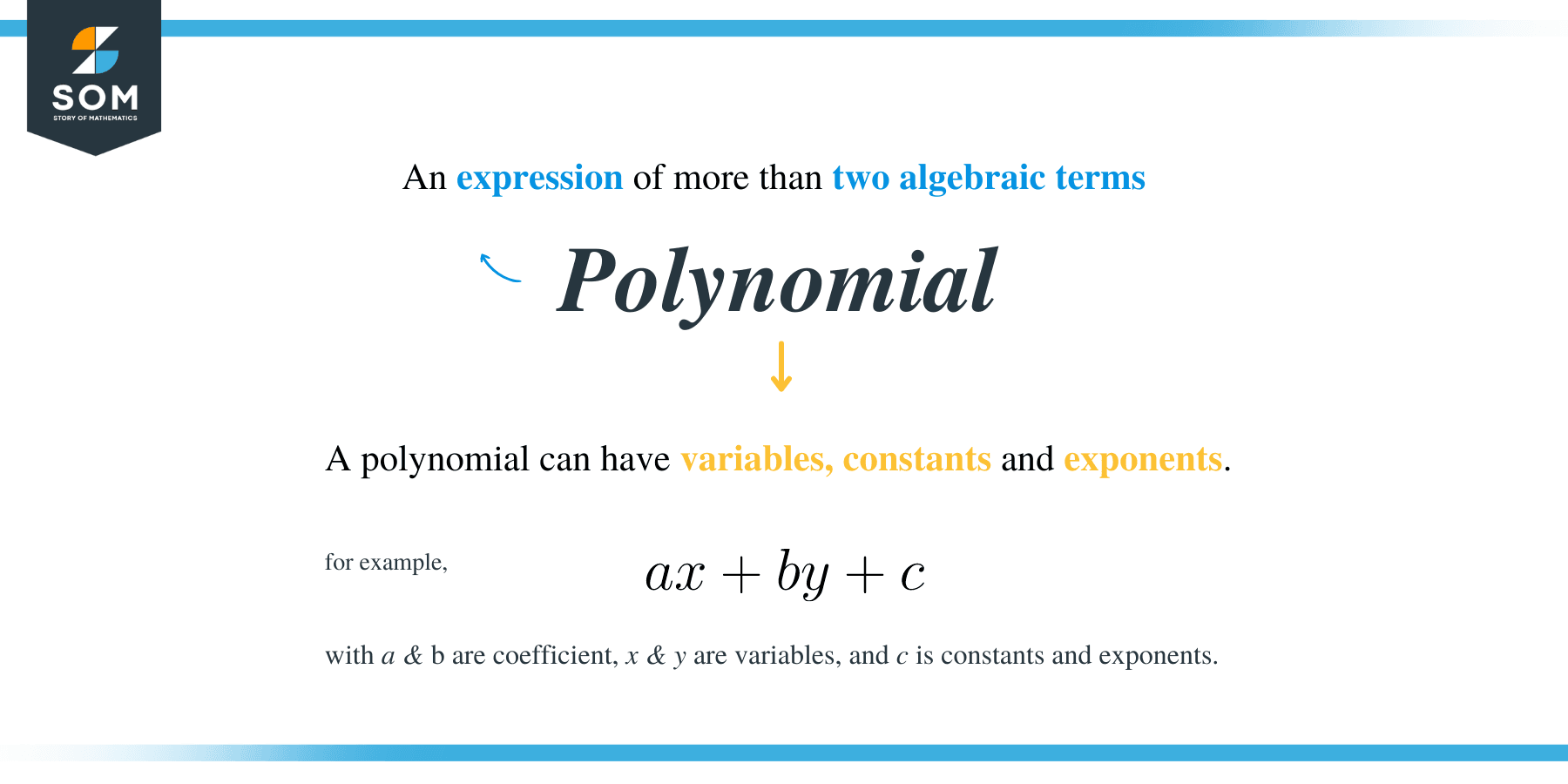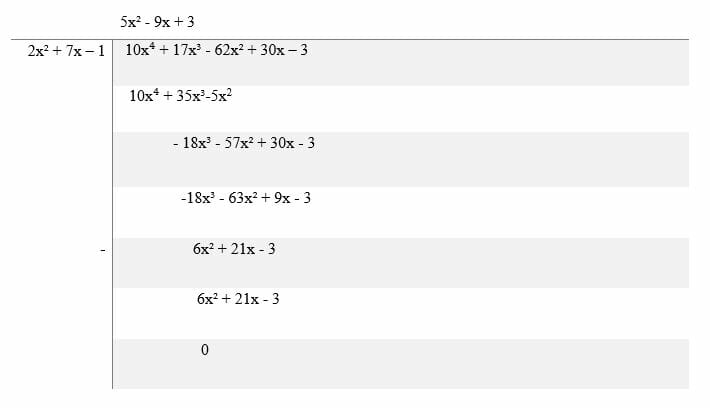- Home
- >
- Remainder Theorem – Method & Examples
Remainder Theorem – Methods & Examples
 A polynomial is an algebraic expression with one or more terms in which an addition or a subtraction sign separates a constant and a variable.
A polynomial is an algebraic expression with one or more terms in which an addition or a subtraction sign separates a constant and a variable.
The general form of a polynomial is axn + bxn-1 + cxn-2 + …. + kx + l, where each variable has a constant accompanying it as its coefficient. The different types of polynomials include; binomials, trinomials, and quadrinomial.
Examples of polynomials are; 3x + 1, x2 + 5xy – ax – 2ay, 6x2 + 3x + 2x + 1 etc.
The procedure of dividing a polynomial by another polynomial can be lengthy and cumbersome. For instance, the polynomial long division method and synthetic division involve several steps in which one can easily make a mistake and thus ending up getting a wrong answer.
Let’s briefly take a look at an example of the polynomial long division method and synthetic division.
- Divide 10x⁴ + 17x³ – 62x² + 30x – 3 by (2x² + 7x – 1) using the polynomial long division method;
Solution

- Divide 2x3 + 5x2 + 9 by x + 3 using synthetic method.
Solution
Reverse the sign of constant in the divisor x + 3 from 3 to -3 and bring it down.
_____________________
x + 3 | 2x3 + 5x2 + 0x + 9
-3| 2 5 0 9
Bring down the coefficient of the first term in dividend. This will be our first quotient.
-3 | 2 5 0 9
________________________
2
Multiply -3 by 2 and add 5 to the product to get -1. Bring -1 down;
-3 | 2 5 0 9
-6
________________________
2 -1
Multiply -3 by -1 and add 0 to the result to get 3. Bring 3 down.
-3 | 2 5 0 9
-6 3
________________________
2 -1 3
Multiply -3 by 3 and add -9 to the result to get 0.
-3 | 2 5 0 9
-6 3 -9
________________________
2 -1 3 0
Therefore, (2x3 + 5x2 + 9) ÷ (x + 3) = 2x2– x + 3
To avoid all these difficulties when dividing polynomials by either using the long division or synthetic division method, the Remainder Theorem is applied.
The remainder theorem is useful because it helps us find the remainder without the actual polynomials division.
Consider, for example, a number 20 is divided by 5; 20 ÷ 5 = 4. In this case, there is no remainder or the remainder is zero, 2o is the dividend when 5 and4 are the divisor and quotient, respectively. This can be expressed as:
Dividend = (Divisor × Quotient) + Remainder
i.e.20 = (5 x 4) + 0
Consider another case where a polynomial x2 + x – 1 is divided by x + 1 to get 4x-3 as the quotient and 2 as the remainder. This can also be expressed as:
4x2 + x – 1= (x + 1) * (4x-3) + 2
What is the Remainder Theorem?
Given two polynomials p(x) and g(x), where p(x) > g(x) in terms of degree and g(x) ≠0, if p(x) is divided by g(x) to get q(x) as quotient and r(x) as remainder, then we can represent this statement as:
Dividend = (Divisor × Quotient) + Remainder
p(x) = g(x) * q(x) + r(x)
p(x) = (x – a) * q(x) + r(x),
But if r(x) = r
p(x) = (x – a) * q(x) + r
Then;
p(a) = (a – a) * q(a) + r
p(a) = (0) *q(a) + r
p(a) = r
According to the Remainder Theorem, when a polynomial, f (x), is divided by a linear polynomial, x – a the remainder of the division process is equivalent to f (a).
How to use the Remainder Theorem?
Let’s see a few examples below to learn how to use the Remainder Theorem.
Example 1
Find the remainder when the polynomial x3 – 2x2 + x+1 is divided by x – 1.
Solution
p(x) = x3 – 2x2 + x + 1
Equate the divisor to 0 to get;
x – 1 = 0
x = 1
Substitute the value of x into the polynomial.
⟹ p (1) = (1)3 – 2(1)2 + 1 + 1
= 2
Therefore, the remainder is 2.
Example 2
What is the remainder when 2x2 − 5x −1 is divided by x – 3
Solution
Given the divisor = x-3
∴ x – 3 =0
x = 3
Substitute the value of x in the dividend.
⟹ 2(3)2 − 5(3) −1
= 2 x 9 − 5 x 3 − 1
= 18 – 15 − 1
= 2
Example 3
Find the remainder when 2x2 − 5x − 1 is divided by x – 5.
Solution
x – 5 = 0
∴ x = 5
Substitute the value x = 5 in the dividend.
⟹ 2(5)2 − 5(5) − 1 = 2 x 25 – 5 x 5 − 1
= 50 – 25 −1
= 24
Example 4
What is a remainder when (x3 – ax2 + 6x – a) is divided by (x – a)?
Solution
Given the dividend; p(x) = x3 – ax2 + 6x – a
Divisor = x – a
∴ x – a = a
x = a
Substitute x = a in the dividend
⟹ p(a) = (a)3 – a(a)2 + 6a – a
= a3 – a3 + 6a – a
= 5a
Example 5
What is the remainder of (x4 + x3 – 2x2 + x + 1) ÷ (x – 1).
Solution
Given the dividend = p(x) = x4 + x3 – 2x2 + x + 1
Divisor = x – 1
∴ x – 1 = 0
x = 1.
Now substitute x = 1 into the dividend.
⟹ p (1) = (1)4 + (1)3 – 2(1)2 + 1 + 1 = 1 + 1 – 2 + 1 + 1 = 2.
Hence, 2 is the remainder.
Example 6
Find the remainder of (3x2 – 7x + 11)/ (x – 2).
Solution
Given the dividend = p(x) = 3x2 – 7x + 11;
Divisor = x – 2
∴x – 2 =0
x = 2
Substitute x = 2 in the dividend
p(x) = 3(2)2 – 7(2) + 11
= 12 – 14 + 11
= 9
Example 7
Find out whether 3x3 + 7x is a multiple of 7 + 3x
Solution
Take p(x) = 3x3 + 7x as the dividend and 7 + 3x as the divisor.
Now apply the Remainder Theorem;
⟹ 7 + 3x = 0
x = -7/3
Substitute x = -7/3 in the dividend.
⟹ p(x) = 3x3 + 7x = 3(-7/3)3 + 7(-7/3)
⟹-3(343/27) – 49/3
⟹ -(345 – 147)/9
= -490/9
Since the remainder – 490/9 ≠ 0, therefore 3x3 + 7x is NOT a multiple of 7 + 3x
Example 8
Use the Remainder theorem to check if 2x + 1 is a factor of 4x3 + 4x2 – x – 1
Solution
Let the dividend be 4x3 + 4x2 – x – 1 and the divisor be 2x + 1.
Now, apply the Theorem;
⟹ 2x + 1 = 0
∴ x = -1/2
Substitute x = -1/2 in the dividend.
= 4x3 + 4x2 – x – 1 ⟹ 4( -1/2)3 + 4(-1/202 – (-1/2) – 1
= -1/2 + 1 + ½ – 1
= 0
Since, the remainder=0, then 2x + 1 is a factor of 4x3 + 4x2 – x – 1

